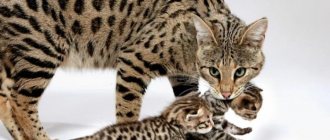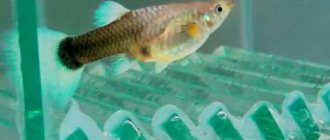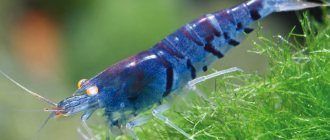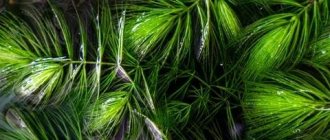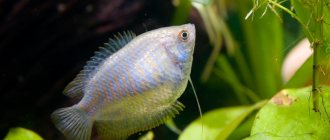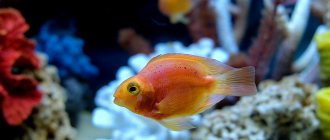Origin of the species and description
Photo: Eublefar
Leopard geckos are small lizards from the leopard gecko family. Formally, they belong to geckos and are their suborder. Geckos have a fleshy, dense body, a large tail and a short, flattened head. The progenitor of all geckos and leopard geckos is the lizard Ardeosaurus brevipes (Ardeosaurus). Its remains are found in fossils from the Jurassic period, and its constitution resembles an almost unchanged gecko. The body of Ardeosaurus was approximately 20 cm long, with a flattened head and large eyes. It was probably a nocturnal predator, and its jaws were specialized for feeding on insects and spiders.
Interesting fact: Leopard geckos were discovered in 1827, and got their name from the combination of the words “eu” and “blephar”, which means “true eyelid” - this is due to the fact that leopard geckos have a movable eyelid, which many lizards do not have.
In general, the modern order of geckos includes the following families of lizards:
- geckos;
- carpodactylids, living exclusively in Australia;
- diplodactylidae, leading a predominantly aquatic lifestyle;
- leopard geckos;
- Philodactylidae are lizards with a unique chromosome rearrangement. They live mainly in hot countries;
- Spaerodaclitidae are the smallest representatives of the order;
- Scalepods are unique representatives that resemble snakes in appearance because they do not have legs. They are still classified as lizards, since they have the structure and lifestyle of the gecko order.
Geckoformes are a very large order, which includes more than a thousand species and about a hundred genera. The identification of individual species of lizards is controversial, since many of them differ from each other only at the molecular level.
Appearance and features
Photo: What does a leopard gecko look like?
Leopard geckos come in different types, depending on which their color and size vary. Typically, adults are approximately 160 cm in size, excluding the tail. The tail of these lizards is their characteristic feature. It is thick, much shorter than the body and very mobile. It has a leaf-shaped form. Leopard geckos have a disproportionately large head. Unlike other lizards, it is not elongated, but flattened, similar to an arrowhead.
Video: Eublefar
The movable neck expands into a rounded body, which also tapers towards the end. The eyes of the leopard gecko are large, from light green to almost black, with a thin black pupil. Small nostrils are clearly visible on the muzzle. The mouth line is also clear, the mouth is wide, which is why the leopard gecko is called the “smiling lizard”.
The leopard gecko has a thick, bright red tongue, which it often uses to lick its face and eyes. The color of lizards is very diverse: from white, yellow, red to black. They often have some kind of pattern on the body - small brown spots (like a leopard gecko), stripes, black asymmetric spots, etc. The entire body of leopard geckos is covered with raised soft growths. Despite their thin legs, leopard geckos run well. They move by wriggling their whole body in the likeness of a snake, although they cannot reach high speeds.
Now you know where the lizard is found. Let's see what to feed the leopard gecko?
Five reasons to get a leopard gecko
Scaly cat: a little about how to keep a leopard gecko
The environmental situation around us is increasingly conducive to the development of allergic reactions. What to do if your child is allergic to cats or dogs? Get a bird. And what if it’s for down or feather?
It is impossible to convey the full magnitude of the grief of a child who dreams of having a little fluffy kitten. Childish tears when watching a cartoon about Carlson, when the Kid does not find a dog on his birthday, cannot be calmly endured by any parent! So what kind of pet should you get if your child is allergic to wool?
A hypoallergenic animal with kind cat eyes and an easy-going disposition, unusual and unpretentious for the home - the spotted leopard gecko. These charming animals have a long life span (with proper care, of course) of 9-12 years. They know how to get used to their owners, recognize them and even “cozy up”. Keeping a leopard gecko (as leopard geckos are also called) at home will not bring any special problems. And what a pleasure it is to watch a cute lizard lap up water like a tiny kitten!
Five reasons to buy a leopard gecko
1. Gecko does not cause allergies.
2. On the scale of comparison of “pet cuteness” - it is not inferior to cats and is many times ahead of them in the absence of the smell of excrement. And this, I must say, is a lot!
3. A spotted leopard gecko at home is a guarantee of cleanliness and silence. “Yes, all reptiles are quiet!” - you say. However, it will be difficult to argue that not all snakes, lizards and even snails (although they are not related to reptiles, but in terms of quietness few are ahead of them in the ratings) are so cute.
4. Spotted leopard geckos (leopard geckos) are animals whose main activity occurs at night, which means there is no need to purchase expensive UF lamps or heating lamps. Natural light is perfect for your pet.
5. Gecko is an animal that does not require overexposure. This wonderful beast will let you go on a weekend or vacation without blinking an eye (although we personally recommend that you look at how original the leopard gecko blinks)! Food for the gecko is insects, you can add 2-3 of them directly into the aquarium. Don’t worry: he’ll catch you and won’t eat too much! Or you can arrange a fasting weekend - for the animal such a “hunger strike” will be very useful, and the appetite will have worked up by the time you return!
6. Yes, yes! It is written - five reasons, but we also indicate the sixth - not the most important, but not without meaning. Zublefar can throw off its tail when frightened or stressed. It seems that there is no one who in childhood saw a lizard without a tail more than once, but never met one that would show how it threw it off and grew it back!
What color is a leopard gecko?
So, the spotted leopard gecko is a potty-trained animal: it does not litter, it chooses one place for the toilet, it is quiet and unusually cute. All so scaly with cute pimples and incredibly bright in the combination of colors, the color of the gecko can be anything. Anyone at all! The blue ones haven't been released yet. Yellow, white, pink, almost cherry and garnet red, black, albino with red or light eyes, with or without patterns - spotted leopard geckos can be the most unpredictable morphs.
Eublefar at home
Decision is made. An exotic creature will live in the house - the cutest representative of the family of tenacious reptiles, the spotted leopard gecko. The word “exotic” evokes a feeling of something unusual and “terribly” difficult to contain. Unusuality - yes, there is: the animal is very beautiful and at the same time unusual for a pet in our country. But a closer acquaintance with him will show that this, if not the ideal pet, is very close to it! And keeping it will not be difficult if you familiarize yourself with the animal’s requirements in advance and follow them. Then the gecko will be comfortable, and you will get a lot of positive emotions, and the children will be simply delighted!
Let's start with the fact that the animal will not give you “surprises” in the most unexpected places: they are very clean and in the terrarium they define a “latrine” for themselves, so it will not be difficult to clean the territory, without the fear of running into “mines”.
In nature, the gecko can be found on the slopes of low mountains, in dry steppe areas, practically devoid of any vegetation. At home, creating conditions close to natural will not be difficult: provide a heated place in the terrarium (so that there is a place to soak up after a hearty lunch), a couple of shelters and clean water. Probably, among reptiles, the leopard gecko can be called the most unpretentious in maintenance.
Unlike some of their counterparts, leopard geckos do not have suction cups on their legs, which allows them to be kept in an aquarium without a lid if the walls are high. But long-term keeping in an aquarium is not recommended, since there is no normal air circulation. It is best to place the reptile in a terrarium where there is additional bottom ventilation, which will make your pet’s life much more comfortable.
Terrariums
If you purchased one gecko, then a small terrarium (dimensions 40:40:40 or 50:40:40 cm) will be enough for it. You can buy a terrarium in our store. Even if you decide to get a group of animals, you won’t need a large living space for them: a horizontally arranged terrarium with dimensions of 50:30:30 cm will be enough. You can also use a vertical structure, but the back wall will have to be equipped accordingly - the reptiles must be able to move around it, take refuge in prepared holes.
A newly acquired baby should not be immediately placed in a “mansion” - not only will it be uncomfortable, but hunting will also be difficult, and accordingly, the cub will starve. From about six months, the leopard gecko will begin to explore the surrounding space, and then it can “apply for expansion.” By the way, in a large terrarium, your gecko will grow faster.
Temperature
Spotted geckos are cold-blooded reptiles and require warmth to digest their lunch. The best choice is a heating device from below. In our pet store you can buy a thermal mat and a thermal cord.
The heating device should be placed in one of the corners of the terrarium so that a third to a quarter of the total area is heated. The temperature in this place must be maintained at 26-28 C, regulating it by changing the thickness of the soil, measuring it with a thermometer. At room temperature less than 22 C, you can turn off the heater at night. Cubs up to three months of age require constant heating.
Ground and shelters
It is convenient and hygienic to use carpets produced for arranging terrariums. It looks great, is easy to keep clean, and your pet will probably love it. Stones and large pebbles are suitable for the ground (it is not recommended to use sea pebbles - the leopard gecko's paws will slide on a well-polished surface). Do not take pebbles that are too small: the animal may swallow them, and then problems are inevitable. For the same reason, you should not use sand. A blockage in the animal's intestines may occur only because you chose too shallow soil, no matter what kind - stones, sand, coconut shavings, etc. For kids, it’s generally better to lay napkins or paper towels.
Of no small importance in the life of a gecko is the ability to hide in a shelter - there should be several of them in the territory of the terrarium, including both the heated part and the “cold” one. In this case, the leopard gecko will have a choice of where to settle. Be sure to provide a place where the lizard will molt. A humid chamber is placed in a warm corner, which your pet will most often use for rest. Good shelters are made from coconut halves - environmentally friendly, inexpensive and practical. You can buy shelters or order shelters in our online store, but you can also practice making them yourself.
Lighting
Spotted geckos are crepuscular animals, so they do not require lighting. You can use an ordinary 25-40W incandescent mirror lamp to imitate the heat of the sun, but it will be better for your pet if you arrange bottom heating.
Your gecko will need UV radiation - without it, vitamin D3 cannot be synthesized. Special ultraviolet lamps have been developed for amphibians (manufactured by UVB, ReptiGlo, etc.). At the same time, if you have equipped bottom heating, and the lizard’s diet contains vitamins and mineral supplements, then you can do without a UV lamp. Please note that spotted geckos (especially albino ones) do not like bright light.
Sometimes UV is indicated in certain situations: if it is necessary to stimulate reproduction or for some reason vitamin D3 is not absorbed, as a result of which rickets develops. For rickets, it is enough to irradiate a quarter of an hour a day, and an artificial increase in the duration of daylight hours, up to 12 hours, will help stimulate reproduction.
Water regime and humidity
The drinking bowl should be small and low. The leopard gecko is content with clean, standing water - give the chameleon a fountain! It's funny to watch the gecko lap up the water - it really is a kitten with scales! If you spray the terrarium every day, then you can do without a drinker at all - the leopard gecko will happily lick off droplets of water. You can buy a drinking bowl at a pet store to match the overall design of the terrarium.
The terrarium needs to maintain a certain humidity - about 50%. If the apartment is dry, then you can humidify the air inside the terrarium by spraying the soil in some corner of the terrarium. This must also be done if you have not yet equipped a wet chamber. The camera is needed for the normal molting of the animal, which in adults occurs once every month or two, and in adolescents - every half month - as they grow up, they change the skin for a new one.
The molting period is very important: the lizard must completely get rid of its previous skin - nothing should remain on the fingers, muzzle, or ears, otherwise health problems will appear. The shed skin goes “for lunch”, so you can skip the moment of molting. A sign that your friend is planning to change his clothes is peeling, cracking and pale skin. This is where you will need a wet chamber - a small closed container that imitates a mink. Vermiculite, coconut shavings or other suitable substrate are placed at the bottom of the improvised hole.
The ideal shedding is when the skin is removed with a single stocking. This happens with normal maintenance, nutrition of your pet and good health. If there is skin left on some parts of the lizard’s body, hold it under running warm water, then carefully remove the remaining skin with a cotton swab.
About ventilation
Good air access and ventilation are vital for the gecko. The air movement must be constant, which is facilitated by warm air in the terrarium, which is replaced by cold air. If the air flow becomes stagnant, the animal may develop serious health problems, which will create problems for you as well. Fungus, dermatitis, inflammation - this can be avoided with good air circulation.
As you can see, there are no particular difficulties, and the pleasure from communicating with a cute, affectionate and unpretentious animal will be truly enormous!
Where does the leopard gecko live?
Photo: Spotted leopard gecko
There are five species in the genus of leopard geckos, which live in different geographical locations:
- The Iranian leopard gecko lives in Iran, Syria, Iraq and Turkey. He chooses an area with a lot of stones. This is one of the largest species of leopard geckos;
- Fiscus settles in dry Indian regions. Its size reaches 40 cm, and a distinct yellow stripe runs down its back;
- Hardwick's leopard gecko lives in India and Bangladesh. This is the least studied species;
- The Leopard Gecko is the most common type of leopard gecko and is also popular for home breeding. In the wild it lives in Pakistan and northern India. They are small individuals up to 25 cm long. Being a popular terrarium animal, the spotted leopard gecko has bred many morphs (lizards of other sizes and colors) that are not found in the wild;
- The Afghan leopard gecko lives exclusively in Afghanistan, and recently began to be considered as a separate subspecies. More often referred to as the Iranian leopard gecko;
- The Turkmen leopard gecko lives in southern Turkmenistan, choosing the area near the Kapet-Dag mountains.
Leopard geckos prefer rocky or sandy terrain. This depends on their color, which is an important part of the lizard's camouflage. They hide under stones or bury themselves in the sand, becoming invisible and immune to the scorching sun.
Don't feed insects that are too large.
Insects may be too large to digest easily, so you should make sure they are the right size before feeding. The general rule is not to feed your gecko any insects that are longer than the distance between the leopard gecko's eyes.
Overfeeding leopard geckos
Most leopard geckos stop eating when they are full, while others try to eat as much as possible. If your gecko seems like he/she is eating too much, you should not overfeed your leopard gecko because this may cause him/her to gain excess weight and this may cause him to regurgitate his food.
If you're concerned that your leopard gecko is eating too much, here's how to tell. Just like humans, overweight leopard geckos will begin to develop a large stomach and will begin to store fat in other parts of the body (except the tail).
Here are some general rules regarding overweight leopard geckos:
- Their belly area should be mostly flat unless they have eaten.
- Their tail should not be wider than their body.
If you suspect that you are overfeeding your leopard gecko, you should reduce the amount of food you offer and/or remove fatty insects from the diet until the leopard gecko loses weight.
How to feed leopard geckos
Leopard gecko feeding schedule
The feeding schedule for leopard geckos depends on their age and health.
Young geckos need to be fed every day, while healthy adult geckos (one year old or older) need to be fed once a week.
If you have a sick or weak gecko, it should be fed every day until it gains strength or returns to its normal healthy size.
Safe insects for leopard geckos
Leopard geckos will eat almost any bug that crawls in front of them. However, not all insects are safe or healthy to eat. Below is a list of the most popular insects:
Crickets – Crickets are the most popular insect for leopard geckos. They are healthy because they are raised specifically for feed and are easy to buy. When feeding crickets to your leopard gecko, you need to make sure that they are not too large for your leopard gecko to easily digest.
Zoophobus is another staple for leopard geckos. They are easy to buy. Zoofobus should be fed to your leopard gecko occasionally as a treat (maximum once or twice a week) because they are high in fat and can be addictive to some leopard geckos.
Silkworms – Silkworms are beneficial to leopard geckos and are excellent insects to add to the diet. They can be expensive and usually don't last long, only a few weeks, so order them in small quantities.
Mistakes in feeding leopard geckos. Below are some mistakes that are harmful to the health of geckos.
Lightning bugs/fireflies/or other glowing insects - If the insects can glow or glow in the dark, then you should not give it to leopard geckos. The chemical that makes these beetles glow is highly toxic to geckos, and even one beetle can contain lethal amounts of the toxin.
Insects you catch outside or in your home - You should never feed your leopard gecko any insects you catch. The reason is that wild insects may contain parasites that can infect your gecko. In addition to parasites, many insects also contain some amount of pesticides that can be toxic to geckos.
What does a leopard gecko eat?
Photo: Leopard gecko
In the wild, leopard geckos are active hunters - they wait in ambush for various insects or even small mammals. For a short time, lizards are even able to pursue their prey, making short, rapid jerks.
Interesting fact: Sometimes leopard geckos do not disdain cannibalism, eating small individuals of their species.
At home, leopard geckos are fed the following foods:
- crickets – banana, two-spotted, brownie;
- Turkmen cockroaches, which reproduce well and are quickly digested;
- marble cockroaches;
- larvae of Madagascar cockroaches;
- newborn mice for large species of leopard geckos;
- butterflies and moths, which can be caught in the summer away from agricultural facilities and not within the city;
- grasshoppers. But before giving the grasshopper to the leopard gecko, you need to tear off its head, since the grasshopper can grab the lizard with its jaws and damage the pet;
- mealworm.
Before feeding, leopard geckos are given plant food so that the insect meat is better digested. It is best to give specialized supplements in the form of vitamins, dry herbs and calcium. Leopard geckos ignore berries, fruits and vegetables. It is best to feed your leopard gecko with tweezers, bringing the food directly to its face. Otherwise, during the hunt, the leopard gecko may eat earth or pebbles, and the cockroach or cricket will successfully escape from the terrarium. Feeding occurs no more than 2-3 times a week, but you need to feed at least five crickets.
Leopard geckos eat only live food, and if, for example, a grasshopper was killed, then it is important that it is fresh. Leopard geckos also need a lot of fresh water - it needs to be changed every day, creating a small flat bath in the terrarium.
The leopard gecko is your ideal pet!
The spotted leopard gecko, also known as the leopard gecko, is an excellent pet for complete beginners and for experienced terrarium keepers. This is a lizard that is very easy to care for and will delight you every day with its signature smile. It is not for nothing that one of the names of the spotted leopard gecko is the smiling gecko.
Leopard geckos are not demanding; creating optimal living and feeding conditions and caring for them is easy. They are great for children, provided that an adult takes on the main responsibilities of caring for the gecko and monitors how the child handles the pet. The leopard gecko is easy to tame, and he will happily sit on your shoulder, bask and sleep on your neck, run around your arms, and clearly show his owner his desires - to eat, go home to the terrarium, chat with you.
These geckos are beautiful, have many varieties of color, to suit any aesthetic taste. The eyes of leopard geckos deserve special attention; they are beautiful in their own way for each morph (variety).
These animals are active at dusk and at night, resting during the day. Morning and evening are the best times to interact with your pets.
In nature, leopard geckos are desert dwellers, nocturnal, insectivorous lizards native to Afghanistan, Pakistan and Iran.
These geckos are very hardy and breed easily in captivity. There are many interesting morphs and colors, ranging from natural (Normal) - yellow-orange with frequent specks, to all sorts of shades of orange (Tangerine), yellow (Raptor), brown, sand, gray, with and without stripes, with spots and evenly colored , bright and delicate, different, very different!
Don’t forget that the coloring of a leopard gecko as a child is often very different from the coloring of an adult, so before you buy in an emotional outburst of “oh, what a lizard!”, find out what your pet will look like in six months, what nuances of keeping and breeding this particular one has morphs.
An adult leopard gecko can be from 20 to 30 cm from the tip of the nose to the tip of the tail, depending on the morph and heredity. Spotted leopard geckos are born about 6 cm in length, by one year they grow to adult size and acquire a color that will remain for the rest of their lives. Leopard geckos live in nature for about 5-8 years, and with proper maintenance and proper breeding, leopard geckos at home can live up to 20 years.
When choosing a pet, be sure to consider the gender of the animals. Females can (and I would say, preferably) be kept in groups of several individuals, but males will need to be kept alone. You can keep together female leopard geckos of approximately the same size; they will communicate very touchingly with each other, help moult, sleep in an embrace, and will give you many beautiful shots for your photo album. Read more about keeping leopard geckos in the “contents” section.
The gender of the leopard gecko baby depends on the temperature and incubation time of the eggs. It is quite easy to distinguish adults by sex. Read about this in the “breeding” section.
Feeding leopard geckos does not pose any problems; the main food is crickets or cockroaches. If you feed live insects, make sure that they (the insects) are fed varied and well-fed. An “empty” cricket will not bring any benefit to your pet, in which case you can assume that you simply did not feed the gecko... The easiest to handle and complete food option is frozen crickets.
As a rare delicacy and only for adult individuals, you can feed mealworms, zoophobos, hawk moth caterpillars, and moths. The leopard gecko's diet must include vitamin and mineral supplements and calcium with vitamin D3. Take care of this in advance so that your handsome leopard gecko is healthy and cheerful.
For answers to all questions related to what and how to feed your leopard gecko, see the “Feeding” section. Feeding leopard geckos is a special pleasure. Watching them hunt for a cricket, this expressive look and movements... it’s better to immediately watch the video if you’ve already seen it)) (video)
To keep leopard geckos, you can use either a terrarium or a plastic container - it depends on your desires and preferences. Mandatory requirements for an “apartment” for your pet are proper ventilation, cleanliness, temperature, size, the presence of shelters and a humid chamber, a drinking bowl and a calcium bowl. If you follow these simple conditions, your pet will be healthy and cheerful. All other additions to the design of the terrarium are your personal aesthetic and functional choice. We consider a terrarium for leopard geckos here.
Leopard geckos are very clean, odorless animals, so cleaning the terrarium is simple - change the napkin in the “toilet”, pour clean water, check the wet chamber to see if it is dry, check for calcium in the bowl. All. Once a week, change the napkins on the floor of the terrarium if you keep animals on napkins. All questions - is it possible to use sand, is driftwood needed, what is a toilet, how to make a wet chamber with your own hands - read in the “Contents” section.
Of particular interest to future owners of leopard geckos is the question “what to do if the lizard drops its tail?” . Firstly, if the animals live peacefully in your terrarium, if you yourself do not expose them to stress, if the shelters do not have sharp edges on which the lizard can get hurt during molting, then it will not want to part with its tail just like that. But if suddenly this happens, don’t lose calm, read and look at the photos, feed your pet well and wait for a new tail to grow.
Another area that deserves attention is where, from whom, at what price, and most importantly, why and why you should buy your first or not your first leopard gecko.
- How to choose a healthy gecko?
- How can I safely place him with other leopard geckos?
- What could your child's first leopard gecko look like?
- How to teach him how to properly handle a lizard?
- How to make your leopard gecko of any age want to become tame?
Every question is important. It shows how valuable this small and charming creature with beautiful eyes, in which the wisdom of centuries is visible, is for you...
Read, find answers, gain experience, write to me, and be in harmony with nature!
Features of character and lifestyle
Photo: Leopard gecko lizard
Leopard geckos are friendly lizards that are nocturnal. In the wild, during the daytime they hide in dug shelters, under stones and other objects. At night, they go out into the open, where they disguise themselves as their surroundings and wait for prey. Leopard geckos have become popular pets due to their personalities. They are not at all aggressive towards humans, they will never bite and will not be afraid (if, of course, you handle the lizard correctly). They are ideal for keeping in homes where there are other friendly animals or children.
In the wild, leopard geckos are solitary, but in terrariums you can keep them in pairs. The main thing is not to place several males in the terrarium, since they will constantly divide the territory, fight and may even injure each other. In the wild, males behave in a similar way: they protect the territory from attacks by other males. Each male’s territory is inhabited by a certain number of females, but they can move freely through different territories. One male and several females get along well in a terrarium.
As shelters, you should add bark, stones, and fixed pieces of trees to the terrarium, where the lizard can hide during the day. But they quickly adapt to a different way of life, especially if the leopard gecko was born in captivity. Then they willingly contact people during the day, feed in the morning, and sleep at night.
Social structure and reproduction
Photo: Leopard gecko
Due to the fact that leopard geckos live in warm regions, they do not have a fixed mating season. The male in his territory randomly pesters females, regardless of whether they are sexually mature. If the female is not ready to mate, she drives the male away. The male is courting the female, who is ready to mate. Its tail begins to vibrate, and sometimes you can even hear the sound of vibration. Then he gently bites her on the back and neck, and if the female does not resist, the mating process begins.
The female herself prepares a place for laying, dragging wet branches, leaves, moss and pebbles there. She moistens the eggs with water, which she brings in the form of dewdrops on her skin. She lays her eggs at night or early in the morning, carefully burying them in damp sand and moss. She guards the clutch jealously, rarely leaving it to feed.
The incubation process is interesting. The fact is that the temperature determines what gender the baby will be:
- at temperatures between 29 and 32 degrees Celsius, males will appear;
- 26-28 – females appear;
- At a temperature of 28-29, both males and females appear.
Incubation can last from 40 to 70 days maximum. The small leopard gecko independently breaks through the soft shell of the egg. The cubs are completely independent, and on the third day they can already hunt.
Breeding leopard geckos
To provoke mating season in leopard geckos, day and night temperatures are lowered to 10-15 degrees for about 1.5 months. It is best to do this in December or January. In February, in this case, the mating process will occur. After about 3-4 weeks, the female lays 1-2 eggs. Until mid-summer, the female can make 4-5 clutches.
The homeland of this lizard is the foothills of Southeastern Afghanistan, Northwestern India and Pakistan.
At a temperature of 28 degrees, eggs develop in 48-62 days. Babies grow quite quickly. Initially, small leopard geckos are fed small crickets. At the same time, both the young and the mother are given vitamins.
It is recommended to separate babies from adults in a separate terrarium, since there is cannibalism among reptiles. When the young animals reach the age of 6 months, they can be kept in the same terrarium with their parents.
Leopard geckos can be kept alone or in pairs, due to the high aggressiveness of males towards each other.
At this age, children's coloring gradually disappears and they acquire a color similar to their parents. Newborn babies make funny sounds, similar to quacks. Sexual maturity in leopard geckos occurs at 1.5-2 years. Adults quack if they are in danger or feel discomfort.
Many people say that leopard geckos are not at all whimsical pets, but this is not entirely true; in order for them to look good and be healthy, they must be carefully looked after.
If you find an error, please select a piece of text and press Ctrl+Enter.
Natural enemies of the leopard gecko
Photo: Female leopard gecko
The leopard gecko is nocturnal because it is afraid of predators.
In the wild, different species of leopard geckos can be hunted by:
- foxes, wolves and dogs - especially if the leopard gecko lives near human habitats;
- cats and rats near villages and cities can also attack the lizard, including at night;
- snakes;
- owls, snake eagles and other large birds of prey. This is especially true for the Turkmen and Iranian leopard geckos, which are large in size;
- Newborn leopard geckos can become prey to other, larger leopard geckos.
No predators conduct targeted hunting of leopard geckos. Lizards lead a secretive lifestyle, and in some cases can even fend for themselves. There is no serious threat from fauna to leopard geckos.
Interesting fact: A male's courtship with a female leopard gecko does not always end in mating. Sometimes the tail vibrating and biting rituals continue for several days. If a male and a female form a permanent pair in a terrarium, then they can mate every day, but fertilization is not possible after every mating. The female carries eggs inside herself - usually from two to nine of them. The first pregnancy lasts one and a half months, all subsequent ones last two weeks.
When to feed your leopard gecko?
Leopard geckos are crepuscular animals, so it is preferable to feed them either in the morning or in the evening. Try to do this at approximately the same time, your pets will quickly get used to this routine and will come to the feeding place in advance.
A leopard gecko crushes a portion of crickets inside.
How often to feed adult leopard geckos and how much crickets to feed is also a question on which there are two opposing opinions. One thing is to feed 5-7 large crickets every 3-4 days; the leopard gecko does not overeat, but also does not eat to its heart’s content. The second is to feed every other day or two and as much as possible until the dog finishes its meal. I suggest a middle way, where the frequency and volume of feeding depends on the life cycles of the lizard. On average, this is twice a week, and the quantity is until the leopard gecko actively attacks the cricket. If he doesn’t want to, don’t “persuade” him, don’t wave a cricket in front of his nose for 5 minutes. If your pet is hungry and has eaten several large crickets in a row, then you will be able to observe “strange” behavior: the gecko bends its neck sideways and down, crushing the eaten crickets inside itself, this is absolutely normal. It usually looks like in the photo on the right.
Regarding additional KOs, I also recommend being restrained and not getting carried away, for me this is 1 “day of treats” per month or two, for pregnant and laying females - more. Of course, a lot still depends on the availability of various FBOs in the area where the breeder lives. It's great to be able to add more variety to your pet's diet, but don't let them overeat.
Hawkmoth caterpillars are additional food and delicacy.
Baby leopard geckos begin to eat from the third or fourth day from birth, we feed them daily 1-2 times a day, 1-2 small crickets, as they grow the quantity increases, from two to three months you can feed them every other day, and the number of crickets reaches up to 4-5 small crickets per intake, by 8-10 months we feed once every 3 days, then switch to an adult diet.
During the feeding process, you can clearly see the character of your spotted leopard gecko, and, if desired, begin to tame it.
Crickets for dinner.
Leopard geckos will eat anything that moves/moves in front of them. You should feed your leopard geckos live or frozen insects. It is difficult to overfeed leopard geckos as they store excess fat in their tail, but it is possible. Therefore, if you notice that your leopard gecko is gaining a lot of excess weight, you may want to cut back on its food intake or remove fatty insects from its diet.
You should feed your leopard gecko early in the morning or late in the evening, as this is usually the time when they begin to hunt in the wild. There is no ideal feeding schedule for leopard geckos, as each gecko has different eating preferences.
Below are the most common feeding schedules among leopard gecko owners:
- For leopard geckos that tend to overeat , feed them the amount you set to prevent them from gaining weight.
- For leopard geckos that are active and maintaining a healthy weight , feed them as much as possible over a 15-20 minute period.
- Geckos that don't eat well - feed them as usual, but leave a dish of worms in the enclosure so they can eat later if they get hungry.
Geckos are known to change their eating habits as they age, so your gecko may love crickets one week and hate them the next. Because of this, many owners rotate their menu of crickets, worms, and other insects to maintain variety in what their geckos eat.
When you feed your leopard gecko, you need to place the worms in a feeding bowl or shallow dish that they can easily reach.
You should put the crickets in their terrarium and place them as close to the gecko as possible so that he/she can see the prey. Some owners only place 2 crickets in their gecko enclosure at a time because it can be difficult to catch the crickets if your gecko decides not to eat them. If you have leftover crickets in the enclosure and your gecko has already eaten, you should remove the crickets. Crickets will molt, crawl onto your gecko, and may bite the tip of your gecko's tail, so it's best to remove them from the tank to save them for another feeding.
